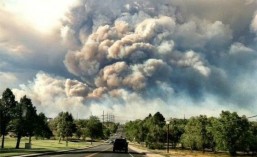No one had been inside the old folks home since the great fire razed it. We three were the first past the warning signs, the razor wire, the fence. We crossed blackened, barren earth and the strange, thick line of spray-painted symbols that ran the gutted husk’s perimeter. Locals we had talked to said the building was believed to be cursed even before everyone inside died. They called it The Dying place. If you were sent there it was to die and few on the outside cared how it happened so long as it did. Hearing the lore only made us want to see inside it more, which we did just after sundown that same day.
Inside the building a heavy silence hung in the cold dead air. The ash remained so thick and undisturbed that every step we took left prints. It was if the air outside couldn’t touch this place. We scanned the rooms, our flashlights low to not give us away if a ranger or sheriff happened by. We had heard it had taken fire crews so long to reach this place they hadn’t bothered trying to put it out. It had burned for a week and it showed, all that was left was ash, concrete, and twisted, heat-warped metal. We weren’t just inside a tomb, but a crematorium. We took plenty of selfies. Our fellow urban-explorers were going to love this.
We explored a few floors but the space was so stripped there wasn’t much to see, until we found the basement. The stairway leading down was made entirely of rough-hewn stone and looked as if it predated the building, possibly by centuries. We drew animals and obscenities into the black soot that covered the walls as we made our way down, our night-vision body-cams recording the descent. The basement was a single, small room with a carved stone table at its center and an ancient cremator set into the back wall. The table, which looked more for rituals than for autopsies, with its perfectly smooth human-shaped indentation, rivulets channels to drain away fluids, and even more unsettling etched symbols than those outside, was still not the strangest item in the room.
Piled in the corner, half buried in a heap of ash, we found three black candles. It was impossible that something as delicate as candles, despite their unexpected heft and strange scent, could have survived such an annihilating fire, and yet each of us held one. There had been no sign of disturbance on the stairs, and when we checked the cremator a small vent was the only other way out. Most people who had come into this room had gone out that way, but we saw no other way in.
Curiosity got the better of me then. I had to know if the candles could be lit. I pulled a weatherproof lighter out of my pack and pressed the crackling plasma against the wick. It caught immediately with what sounded like a raspy exhale. I set the candle onto the stone table and we inspected it as it cast our shadows against the stone walls. I don’t know what made us look up and take notice, but when we did the room fell silent.
There was a fourth shadow.
The edges of it boiled as its holes for eyes bore into us, shackling us in place, all too terrified to move. That’s when it spoke.
“Choose who dies.”
The words came from inside my head along with terrible pain and were accompanied by a sickening array of violent images. I collapsed to my knees, but through the pain came understanding. The shadow had lived here. They had been tied down to the stone, had their blood drained while still alive, and had their tortured soul poured and spellbound into a candle prison. Taking blood had made this nightmare and only taking blood could free it. I shook there on the cold stone, tears now streaming down my cheeks as those hollow, hateful eyes awaited a name. If I refused to give it one it would give mine. I’m so sorry, but what else could I have done? I gave it a name. I gave it yours.
